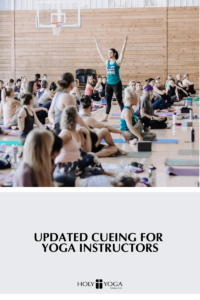
Have you ever had to replace an appliance in your house? Maybe it no longer functioned, or maybe there was a new model that was more efficient. Things get outdated. That is just a fact. Even the cues and directives that instructors provide in their classes can become outdated. Here are a few updated cueing directives that have become outdated and should be replaced with other methods of instruction.
Outdated Cues:
- Roll your inner thighs in
This cue was used in some poses to help the knees stay in alignment with the hip joint (example: bridge pose). However, this cue started to be used in poses in which internal rotation was not needed. Therefore, in certain poses when people add an inner rotation of their thighs to the pose it actually causes their entire leg along with their knee to turn inward instead of facing forward. This brings the knee into misalignment.
- Pull your shoulder blades down when your arms go overhead
This cue was intended to help someone relax the tension they bring into their shoulders when drawing their arms overhead. However, this cue has become commonplace in many poses even when the arms are not overhead. In addition, people tend to overemphasize the shoulder blades coming towards each other, which starts to establish other structural imbalances in the shoulders and neck – this actually causes more tension.
- Align your knees over your toes
When assessing someone’s alignment from a side profile, their knees and pelvis should be stacked over their ankle. This means you should be able to create a plumb line from the center of the ankle up to the center of the knee and toward the center of the hip. This is the correct alignment of the lower body and sets the entire body up for success.
Updated Cueing to Embrace:
- Refer to bony landmarks on a person’s body
Instead of saying something like, “bring your pelvis into neutral,” say this, “draw your pubic symphysis (or pubic bone) forward.”
- Refer to landmarks in the room to assist with directional movement
Students can sometimes become confused or so consumed with trying to figure out their right and left that it moves them out of being present with their body and into a state of frustration.
Instead of saying something like “extend your right leg across your body,” you could bring attention to an aspect of the room like a window to provide the direction of which you want your students to move. An example of this would be, “draw your leg towards the window.”
-
Try a new way to get your students into a pose-
- Use a model in your class (with permission) to demonstrate a pose as you break down all the elements of the pose in front of the class.
- Demonstrate the pose and then invite each student to work through the pose on their own with no verbal cues.
- Pair up your students and allow them to support each other in understanding the pose.
Ensuring you are using updated cueing terms and directives with your students is important in providing the best instruction. One of the many topics in our 300hr training for existing Yoga Instructors is a deeper dive into updated cueing, terminology, and anatomy. If you’re interested in furthering your instructor knowledge, check out our 300hr Instructor Training here!
This article was originally posted as part of our Quarterly Industry Update, which is provided as a resource to all of our Core Members. The Holy Yoga Core Membership is available by subscription to all of our Holy Yoga Instructors. You can learn more about the Core Membership and all of its benefits here!
Sources:
Yoga Journal: 5 Outdated Yoga Cues – https://www.yogajournal.com/teach/5-outdated-yoga-pose-instructions
Verbal Cues for Yoga Poses: The Easiest Ways to Immediately Improve Your Communication – https://www.jasonyoga.com/2018/02/20/improve-verbal-cueing-yoga-teachers/
